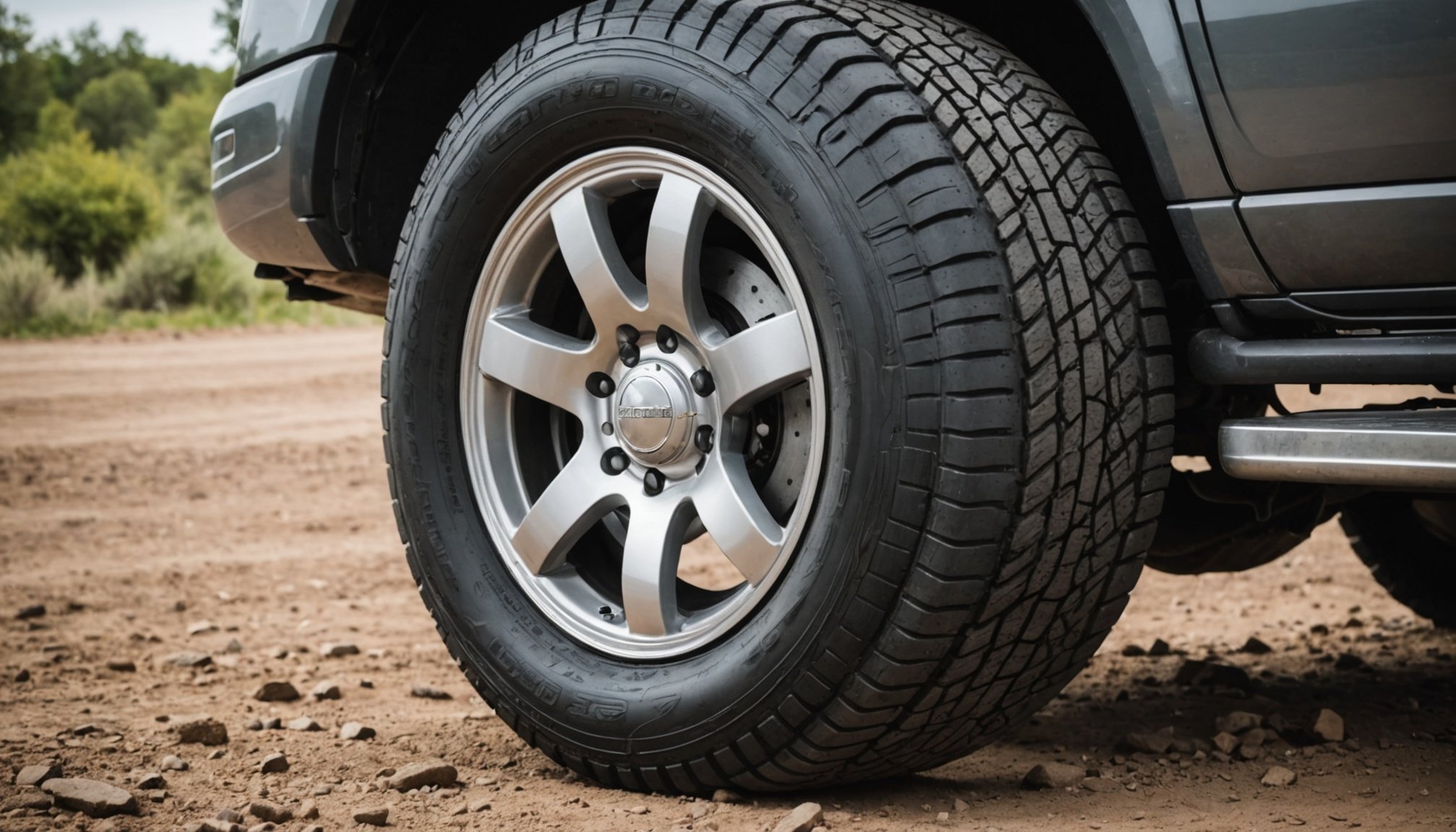Ultimate Guide to Tire Rotation for 4WD Vehicles: Promote Balanced Wear and Boost Safety
Why Tire Rotation is Crucial for 4WD Vehicles
When it comes to maintaining your 4WD vehicle, one of the most critical yet often overlooked tasks is tire rotation. This simple yet effective maintenance practice can significantly impact the performance, safety, and longevity of your vehicle’s tires. Here’s why tire rotation is so important:
Tire rotation helps in distributing the wear evenly across all four tires, which is essential for 4WD vehicles that often face varied and challenging terrains. Uneven wear can lead to reduced traction, compromised handling, and increased risk of accidents. By rotating your tires regularly, you ensure that each tire wears out uniformly, maximizing tread life and improving overall vehicle performance[1][3][4].
Also to read : Elevate your stopping power: key insights for perfecting braking with enhanced ceramic brake pads
Benefits of Regular Tire Rotation
Regular tire rotation offers a multitude of benefits that can enhance your driving experience and extend the life of your tires.
Even Tread Wear
Tire rotation ensures that all four tires wear evenly, which is crucial for maintaining consistent tread depth. This even wear maximizes the lifespan of your tires and improves traction and handling. Uneven wear, on the other hand, can lead to premature tire replacement and compromised safety[1][3].
Also read : Crucial safety tips for safely altering cargo barriers in commercial vans
Improved Fuel Efficiency
Properly rotated tires can improve fuel efficiency by reducing rolling resistance. When tires wear unevenly, it can increase the energy required to move the vehicle, leading to higher fuel consumption. By keeping your tires evenly worn, you can enjoy better fuel efficiency and lower operating costs[1].
Enhanced Safety
Regular tire rotation is a safety imperative. Uneven wear can reduce traction and increase the risk of accidents, especially during sudden turns or braking. By ensuring even tread wear, you enhance your vehicle’s ability to handle various driving conditions safely[1][3].
Extended Tire Life
Tire rotation extends the life of your tires by distributing wear evenly. This prevents any single tire from bearing the brunt of the wear, thereby prolonging the overall lifespan of your tire set. This not only saves you money but also reduces the hassle of frequent tire replacements[1][3].
Better Handling and Performance
Properly rotated tires improve handling and performance, especially during cornering and braking. Even tread wear ensures consistent traction, which is vital for reliable cornering and braking performance. This makes your vehicle more responsive and safer to drive[1][3].
Tire Rotation Patterns for 4WD Vehicles
Choosing the right tire rotation pattern is essential for 4WD vehicles, as it depends on the type of drivetrain and tires your vehicle uses.
Rear-Wheel Drive (RWD) Vehicles
For RWD vehicles, the rearward cross-pattern is typically recommended. This involves moving the rear tires to the front and crossing them over to the opposite side. For example, the rear left tire would move to the front right position, and the rear right tire would move to the front left position[1][4].
Front-Wheel Drive (FWD) Vehicles
For FWD vehicles, a forward cross-pattern is usually advised. Here, the front tires are moved to the rear and crossed over to the opposite side. So, the front left tire would move to the rear right position, and the front right tire would move to the rear left position[1][4].
4-Wheel Drive (4WD) and All-Wheel Drive (AWD) Vehicles
For 4WD and AWD vehicles, an X-pattern or a side-to-side pattern is often recommended. In the X-pattern, the front left tire moves to the rear right, the front right tire moves to the rear left, the rear left tire moves to the front right, and the rear right tire moves to the front left. This pattern ensures even wear across all four tires[1][4].
Directional Tires
If your vehicle is equipped with directional tires, you must follow a front-to-back pattern. This means moving the front tires directly to the rear positions without crossing them over to the opposite side. It’s crucial to adhere to this pattern to maintain the directional integrity of the tires[1].
Step-by-Step Guide to Rotating Tires
Rotating your tires is a straightforward process that you can do yourself with the right tools and a bit of knowledge. Here’s a step-by-step guide:
- Prepare Your Vehicle:
- Put your car in “park” or “gear” if you have a manual transmission.
- Set the parking brake firmly and turn off the engine.
- Place blocks ahead of the tires to prevent the car from moving.
- Loosen the Lug Nuts:
- Loosen the lug nuts using the lug nut wrench, but do not completely remove them.
- Raise the Vehicle:
- Use the jack to raise the car and place it on the jack stands for stability.
- Remove the Tires:
- Completely loosen the lug nuts and remove the tires.
- Mark the tires with a tire crayon for easy identification if needed.
- Rotate the Tires:
- Rotate your tires according to the recommended pattern for your vehicle.
- For example, if you’re using the X-pattern for a 4WD vehicle, move the front left tire to the rear right, the front right tire to the rear left, and so on.
- Reinstall the Tires:
- Screw the lug nuts back in with the lug nut wrench, but do not tightly screw them in yet.
- Lower the Vehicle:
- Slowly lower the car to the ground with the car jack.
- Tighten the Lug Nuts:
- Tighten the lug nuts completely with a torque wrench.
- Repeat the Process:
- Repeat this process until all of your tires have been rotated[1][4].
Importance of Tire Balancing
In addition to tire rotation, tire balancing is another crucial maintenance task that ensures your tires perform optimally.
Why Balance Your Tires?
Tire balancing involves ensuring that all tires support an equal amount of weight. If a tire supports a disproportionate amount of weight, it will wear more unevenly and can cause the wheel to spin irregularly at high speeds. This can lead to damage to the tires and other vehicle components. Balancing your tires prevents this damage, increases their performance and lifespan, and ensures a smoother ride[1].
Benefits of Balanced Tires
- Smooth Ride: Balanced tires spin smoothly at high speeds, reducing vibrations and improving overall driving comfort.
- Even Wear: Balanced tires wear evenly, extending their lifespan and maintaining consistent traction.
- Improved Performance: Balanced tires enhance vehicle performance by ensuring that all tires support equal weight, which is critical for handling and stability[1].
Comparison of Radial and Bias-Ply Tires for 4WD Vehicles
When choosing tires for your 4WD vehicle, you often have to decide between radial and bias-ply tires. Here’s a comparison to help you make an informed decision:
| Feature | Bias-Ply | Radial |
|---|---|---|
| Durability | The thick, layered construction provides exceptional resistance to cuts and punctures, ideal for extreme terrains. | Built with steel belts, radial tires are durable and handle most off-road conditions well, especially with reinforced sidewalls.[2] |
| Ride Comfort | The rigid design results in a rougher ride, especially at higher speeds. | Radial tires offer a smoother ride due to their flexible sidewalls, making them better for mixed-use vehicles.[2] |
| Traction | The rigidity limits their ability to conform to uneven surfaces, reducing traction in some conditions. | Radial tires excel in providing consistent traction across various terrains due to their ability to adapt to surface irregularities.[2] |
| Longevity | Wears out faster due to uneven tread wear, especially on vehicles driven at higher speeds. | Longer-lasting due to even tread wear and better heat dissipation.[2] |
Practical Tips for Maintaining Your Tires
Here are some practical tips to keep your tires in top condition:
-
Check Tire Pressure Regularly:
-
Ensure your tires are inflated to the recommended pressure. Underinflated tires can lead to uneven wear and reduced performance.
-
Align and Balance Wheels:
-
Regular wheel alignment and balancing are crucial to avoid uneven wear. Proper alignment improves handling and keeps your tires in good shape[5].
-
Avoid Overloading:
-
Avoid overloading your vehicle to reduce stress on the tires. Too much weight can wear down the tread faster and decrease tire performance[5].
-
Inspect for Damage:
-
Regularly inspect your tires for damage like cracks, bulges, or punctures. Damaged tires wear out faster and can be dangerous to drive on[5].
-
Replace Tires When Necessary:
-
Replace tires when the tread depth reaches 2/32″. Waiting until they are completely worn out compromises safety[5].
Common Signs of Uneven Wear
Identifying signs of uneven wear is crucial for maintaining your tires. Here are some common signs to look out for:
-
Cupping:
-
Cupping occurs when the tire tread wears in a cup-like shape. This is often due to improper tire balancing or worn-out suspension components.
-
Feathering:
-
Feathering is characterized by tread wear that looks like the feathers of a bird. This is usually caused by improper tire alignment.
-
Scalloped Edges:
-
Scalloped edges occur when the tire tread wears in a wavy pattern. This can be due to underinflated tires or worn-out suspension components.
If you notice any of these signs, it’s important to evaluate whether you’ve been keeping up with regular tire rotations and to address any underlying issues promptly[3].
Tire rotation is a vital maintenance task that can significantly enhance the performance, safety, and longevity of your 4WD vehicle’s tires. By understanding the right rotation patterns, the importance of tire balancing, and how to identify signs of uneven wear, you can ensure your vehicle remains in top condition. Remember, regular maintenance is key to a safe and enjoyable driving experience.
Additional Resources
For more detailed information and specific guidelines tailored to your vehicle, always refer to your owner’s manual. Here are some key resources to keep handy:
- Owner’s Manual: The best source for vehicle-specific tire rotation patterns and maintenance recommendations.
- Mechanic Advice: Consult with a professional mechanic if you’re unsure about any aspect of tire rotation or balancing.
- Tire Manufacturer Guidelines: Follow the guidelines provided by your tire manufacturer for optimal performance and longevity.
By following these guidelines and tips, you can ensure your tires wear evenly, your vehicle performs optimally, and your safety on the road is never compromised.











